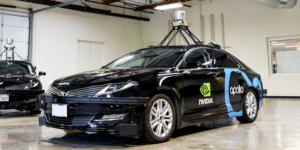Shares of NVIDIA (NASDAQ: NVDA) recently tumbled after a double whammy of bad news. First, one of Uber’s driverless vehicles, which was powered by NVIDIA’s chips, hit and killed a pedestrian. Uber and NVIDIA both suspended their driverless tests after the accident.
Many investors seemingly saw the news as an indicator that NVIDIA’s entire automotive chip business, one of its pillars of growth, was falling apart. But if we take a closer look at the situation, we’ll notice that the situation isn’t really that dire, for four simple reasons.

1. The automotive business is still small
NVIDIA talks a lot about driverless cars, but its automotive revenues only grew 3% annually to $132 million last quarter and accounted for 5% of its top line. Those revenues mainly came from sales of its Tegra CPUs to automakers for their infotainment and navigation systems, as well as its Drive PX “supercomputer” and its new Xavier AI chip for autonomous cars.
That business grew much faster in the past, but the infotainment chip market, where it competes against other players like Intel and Qualcomm (NASDAQ: QCOM), is being commoditized. Those systems are also being replaced by next-gen AI cockpit systems and top to bottom self-driving platforms built on NVIDIA hardware and software.
Therefore, the slowdown is cyclical, as NVIDIA transitions between infotainment systems and end-to-end solutions. If NVIDIA maintains its first mover’s edge in the auto market — which already won over customers like Audi, Mercedes-Benz, Toyota, Tesla, and Uber — its automotive revenues should rebound in the near future.
Last quarter, NVIDIA CFO Colette Kress stated that over 320 companies and research institutions now use its Drive PX platform — a 50% increase from a year ago, including “virtually every car marker, truck maker, robo-taxi company, mapping company, center manufacture and self starter in the autonomous vehicle ecosystem.”
2. Uber wasn’t using Drive PX
Initial reports suggested that Uber’s cars used NVIDIA’s Drive PX platform — which bundles the chipmaker’s real-time sensor fusion, HD mapping, and path planning technologies together — to convert traditional vehicles into autonomous ones. NVIDIA CEO Jensen Huang recently shot down those reports at the company’s GPU Technology Conference in San Jose.

“Uber does not use Nvidia’s Drive technology,” said Huang. “Uber develops their own sensing and drive technology.” Uber’s platform is powered by NVIDIA’s chips, but the problem which caused the fatal crash was likely caused by Uber’s software.
Therefore, Uber’s accident doesn’t mean that automakers will abandon ship and flock toward rival platforms like NXP Semiconductors’ (NASDAQ: NXPI) BlueBox. Qualcomm is notably trying to buy NXP to challenge NVIDIA, but that deal remains in limbo.
3. Its driverless fleet is tiny
NVIDIA’s suspension of its own self-driving tests sounds like big news, but the chipmaker’s driverless fleet consists of just five to six vehicles. The suspension merely means that NVIDIA wants to understand what happened at Uber, and how it can avoid similar accidents.
This doesn’t mean that Drive PX is flawed, or that NVIDIA’s customers are halting their tests or pulling their orders for its automotive chips. Instead, automakers with a long-term view of driverless cars will likely keep buying NVIDIA’s chips.
4. NVIDIA has plenty of bigger growth engines
NVIDIA’s soft growth in automotive chips last quarter was easily offset by massive demand for its GPUs for gaming, professional visualization, and data centers. Its sales growth across those three categories boosted its total revenues by 34% last quarter. Wall Street still expects NVIDIA’s revenue and earnings to rise 27% and 35%, respectively, this year.
Once the current news cycle about Uber and driverless safety dies down, investors should realize that NVIDIA’s sell-off was overdone. The automotive business just generates a small percentage of its total revenues, NVIDIA is still the “best in breed” play in both driverless cars and AI, and the chipmaker has plenty of other growth engines which should help it generate double-digit sales and earnings growth for the foreseeable future.


